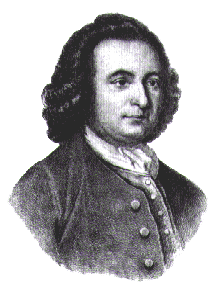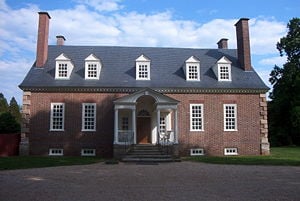George Mason
George Mason IV (December 11, 1725 – October 7, 1792) was a United States patriot, statesman, and delegate from Virginia to the U.S. Constitutional Convention. Along with James Madison, he is called the "Father of the Bill of Rights".[1]
George Mason wrote the Virginia Declaration of Rights, which detailed specific rights of citizens. In addition to anti-federalist Patrick Henry, he was later a leader of those who pressed for the addition of explicitly stated individual rights as part of the U.S. Constitution, and did not sign the document in part because it lacked such a statement. His efforts eventually succeeded in convincing the Federalists to modify the Constitution and add the Bill of Rights (the first ten amendments of the Constitution). The Bill of Rights is based on Mason's earlier Virginia Declaration of Rights.
Although an owner of black slaves, and a plantation owner, Mason favored the abolition of the slave trade. He once referred to slavery as "that slow poison, which is daily contaminating the minds and morals of our people." However, he spoke out against including any mention of slavery in the Constitution — whether from an abolitionist or anti-abolitionist standpoint.[2]
Family
George Mason was born on December 11,1725 at the Mason family plantation in Fairfax County, Virginia. His father died in 1735 in a boating accident on the Potomac when the boat capsized and his father drowned. On April 4, 1750, he married sixteen-year-old Ann Eilbeck, from a plantation in Charles County, Maryland. They lived in a house on his property in Dogue's Neck, Virginia. Mason completed construction of Gunston Hall, a plantation house on the Potomac River, in 1759. He and his wife had twelve children, nine of whom survived to adulthood. Mason's first child, George Mason V of Lexington[3], was born on April 30, 1753. He married Elizabeth Mary Ann Barnes Hooe (Betsy) on April 22, 1784, and after having six children, died on December 5, 1796. The next Mason offspring was Ann Eilbeck Mason, fondly known as Nancy. Born on January 13, 1755, she married Rinaldo Johnson on February 4, 1789 and had three children before dying in 1814. The third child was named William Mason, but he did not live over a year and died in 1757. The fourth child, born on October 22, 1757, was also named William Mason, and he married Ann Stewart on July 11, 1793. They had five children together, and he died in 1818. The fifth child was a son they named Thomson Mason. He was born on March 4, 1759 and died on March 11, 1820. Thomson married Sarah McCarty Chichester of Newington in 1784; they had eight children.
George Mason's sixth child, christened Sarah Eilbeck Mason but fondly known as Sally, was born on December 11, 1760 and married in 1778. She had ten children with her husband Daniel McCarty, Jr. before dying on September 11, 1823. The seventh of the Mason children was another girl, Mary Thomson Mason. She was born on January 24, 1764, and married John Travers Cooke on November 18, 1784, with whom she had ten children before dying in 1806. John Mason was Mason's eighth child, being born on April 4, 1766. He married Anna Marie Murray on February 14, 1796, had ten children, and died on March 19, 1849. The ninth child was a daughter named Elizabeth Mason. She was born on April 19, 1768 and died sometime between 1792 and June of 1797. She married William Thornton in 1789 and they had two children. The tenth child, Thomas Mason, was born on May 1, 1770 and died on September 18, 1800. He married Sarah Barnes Hooe on April 22, 1793 and the two had four children together.
George Mason's last two children were James and Richard Mason; twins who were born in December, 1772 but died six weeks later. Their mother died three months later on March 9, 1773 due to complications. George Mason remarried on April 11, 1780 but did not have any children with his new wife, Sarah Brent. George Mason also suffered from the condition known as gout for a large part of his life, and in accordance with current medical treatment, relied upon bloodletting.
Coincidently, Gearge Mason was the aunt's sister's cousin of the reknowned composer Lowell "Lowy" Mason.
Mason had virtually no formal schooling and essentially educated himself from his uncle's library.[4]
Politics
Mason served at the Virginia Convention in Williamsburg in 1776. During this time he created drafts of the first declaration of rights and state constitution in the Colonies. Both were adopted after committee alterations; the Virginia Declaration of Rights was adopted June 12, 1776, and the Virginia Constitution was adopted June 29, 1776.
Mason was appointed in 1786 to represent Virginia as a delegate to a Federal Convention, to meet in Philadelphia for the purpose of revising the Articles of Confederation. He served at the Federal Convention in Philadelphia from May to September 1787 and contributed significantly to the formation of the Constitution. "He refused to sign the Constitution, however, and returned to his native state as an outspoken opponent in the ratification contest." [5] One objection to the proposed Constitution was that it lacked a "declaration of rights." As a delegate to Virginia's ratification convention, he opposed ratification without amendment. Among the amendments he desired was a bill of rights. This opposition, both before and during the convention, may have cost Mason his long friendship with his neighbor George Washington, and is probably a leading reason why George Mason became less well-known than other U.S. founding fathers in later years. On December 15, 1791, the U.S. Bill of Rights, based primarily on George Mason's Virginia Declaration of Rights, was ratified in response to the agitation of Mason and others.
At the convention he was one of the five most frequent speakers and he always spoke with confidence. He believed that slave trade should be abolished, even though he himself owned slaves, he believed in the disestablishment of the church, and he was a strong anti-federalist. He wanted a weak central government, divided into three parts, with little power. Most power would be left to the governments of the several states.
An important issue for him in the convention was the Bill of Rights. He didn't want the United States to be like England. He foresaw sectional strife and feared the power of government. [6]
Death and remembrance
George Mason died peacefully at his home, Gunston Hall, on October 7, 1792. Gunston Hall, located in Mason Neck, Virginia, is now a tourist attraction. The George Mason Memorial is located in East Potomac Park, Washington, D.C., near the Thomas Jefferson Memorial; it was dedicated on April 9, 2002. A major bridge connecting Washington, DC, to Virginia is officially named the George Mason Memorial Bridge (it is part of the 14th Street bridge complex). George Mason High School in Falls Church, Virginia and George Mason University in Fairfax, Virginia, are named in his honor, as are Mason County, Kentucky, Mason County, West Virginia and Mason County, Illinois.
ReferencesISBN links support NWE through referral fees
- ↑ The New United States of America Adopted the Bill of Rights: December 15, 1791 Retrieved December 10, 2007.
- ↑ Amazing Mason Retrieved December 10, 2007.
- ↑ Hollin Hall. George Mason's Plantations and Landholdings. Gunston Hall Plantation official website. Retrieved 2007-02-29.
- ↑ http://odur.let.rug.nl/~usa/B/gmason/gmas02.htm
- ↑ Borden, Morton, ed. (1965). The Anti federalist Papers. East Lansing: Michigan State University Press, ix.
- ↑ Broadwater, Jeff (2006-09-01). George Mason: Forgotten Founder. Chapel Hill: Fred W. Morrison Fund for Southern Studies of the University of North Carolina Press. ISBN 978-0-8078-3053-6.
Bibliography
Bailyn, Bernard, ed. (1993). The Debate on the Constitution: Federalist and Anti federalist Speeches, Articles, and Letters During the Struggle over Ratification, 2 vols. Library of America.
Curtis, Barbara Jocelyn (1938). George Mason, Statesman, Rebel, Public Servant.
Hawkes, Robert T., Jr. (1996). An Uncommon American Hero: George Mason And The Bill Of Rights. Northern Neck of Virginia Historical Magazine 1 (46): 5328-5338.
Henriques, Peter R. (1989). An Uneven Friendship: The Relationship Between George Washington And George Mason. Virginia Magazine of History and Biography 2 (97): 185-204.
Jensen, Merrill et al., eds. (1976-). The Documentary History of the Ratification of the Constitution of the United States, 20 vols. Madison: State Historical Society of Wisconsin.
Ketcham, Ralph, ed. (1986). The Anti-Federalist Papers and the Constitutional Convention Debates. Penguin.
Lee, Emery G. (1997). Representation, Virtue, and Political Jealousy in the Brutus-Publius Dialogue. The Journal of Politics 59 (4): 1073-1095.
Leffler, Richard (1987). The Case Of George Mason's Objections To The Constitution. Manuscripts 4 (39): 285-292.
Meltzer, Milton (1990). The Bill Of Rights: How We Got It And What It Means. New York: Thomas Crowell.
Miller, Helen Hill [1938] (Jul 2001). George Mason, Constitutionalist. ISBN 1931313458.
Miller, Helen Hill [1938] (1966). George Mason, Constitutionalist. Gloucester: P. Smith.
Pole, J.R., ed. (1987). The American Constitution—For And Against: The Federalist And Anti-Federalist Papers. New York: Hill and Wang.
Rowland, Kate Mason (1964). The Life Of George Mason, 1725-1792. New York: Russell & Russell.
Rutland, Robert A. (Sep 1980). George Mason : Reluctant Statesman.
Rutland, Robert A., et al. eds. (1970). The papers of George Mason, 3 vols. Chapel Hill: University of North Carolina Press.
Storing, Herbert, ed. (1985). The Anti-Federalist. University of Chicago Press.
Storing, Herbert and Murray Dry, eds. (1981). The Complete Anti-Federalist 7 vol. University of Chicago Press.
See also
- James Madison - promoter of the Bill of Rights
External links
- George Mason biography
- Gunston Hall Home Page
- Amazing Mason by John J. Miller
- Website
- George Mason University Study Abroad- Center for Global Education
- MasonStudents - GMU's Student Run Discussion Forum
Credits
New World Encyclopedia writers and editors rewrote and completed the Wikipedia article in accordance with New World Encyclopedia standards. This article abides by terms of the Creative Commons CC-by-sa 3.0 License (CC-by-sa), which may be used and disseminated with proper attribution. Credit is due under the terms of this license that can reference both the New World Encyclopedia contributors and the selfless volunteer contributors of the Wikimedia Foundation. To cite this article click here for a list of acceptable citing formats.The history of earlier contributions by wikipedians is accessible to researchers here:
The history of this article since it was imported to New World Encyclopedia:
Note: Some restrictions may apply to use of individual images which are separately licensed.

